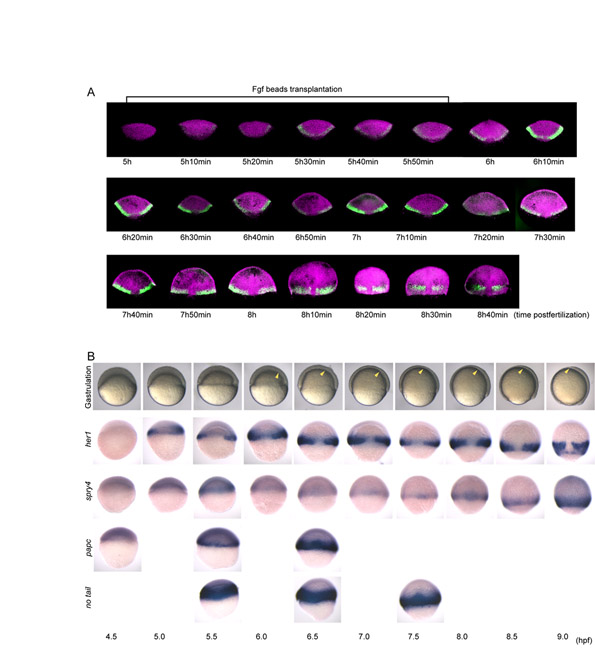Fig. S1 Time-course analysis of expression patterns of her1, spry4, papc, no-tail and the process of gastrulation. (A) To minimize individual differences at developmental stages, we collected embryos by the following method. Embryos that spawn within 10 minutes were collected. Embryos that failed to reach or remain at the 4-, 8- and 16-cell stages within 5 minutes at the fixed time were removed so that the developmental time difference was less than 5 minutes. Ten embryos were then fixed every 10 minutes from 5 hours post-fertilization (hpf) to 8.7 hpf. All procedures were performed in a temperature-controlled room at a fixed 28.5°C. Until 7 hours 50 minutes post-fertilization, her1 oscillation occurs only in the margin area, as reported previously (Riedel-Kruse et al., 2007); the intensity of fluorescence of the her1 mRNA signal repeatedly became stronger and weaker in unison. Then, a traveling wave in a posterior to anterior direction was observed. Under our experimental conditions, traveling waves in a ventral to dorsal direction, as previously reported (Riedel-Kruse et al., 2007), were not observed. (B) The stages of the embryos were strictly controlled as described in A. Gastrulation starts prior to the emergence of the traveling wave and to the anterior expansion of Fgf signaling, indicating that the gastrulation movement is not the primary cause of both events; gastrulation starts at <6.0 hpf and the emergence of the traveling wave and the anterior expansion of Fgf signaling begins at <8.0 hpf. The anterior limit of gastrulating mesoderm is indicated by yellow arrowheads in live embryos (top). The emergence of the traveling wave of her1 and the anterior expansion of Fgf signaling occur at the same stage (8.0 hpf). In addition, both her1 and spry4 are first detected at the same stages (5.0 hpf), suggesting that the early oscillation of her1 also depends on Fgf signaling. papc expression (a marker for the PSM) gradually becomes broader as gastrulation proceeds, while her1 expression remains restricted to the marginal area, supporting the idea that involuting mesoderm cells transiently express her1 before they leave the marginal area and then become negative. no-tail expression (a pan-mesodermal marker) is not identical to that of her1 (the no-tail expression domain is wider than that of her1), indicating that Fgf signaling differentially regulates mesoderm maintenance and clock oscillation.
Image
Figure Caption
Acknowledgments
This image is the copyrighted work of the attributed author or publisher, and
ZFIN has permission only to display this image to its users.
Additional permissions should be obtained from the applicable author or publisher of the image.
Full text @ Development

